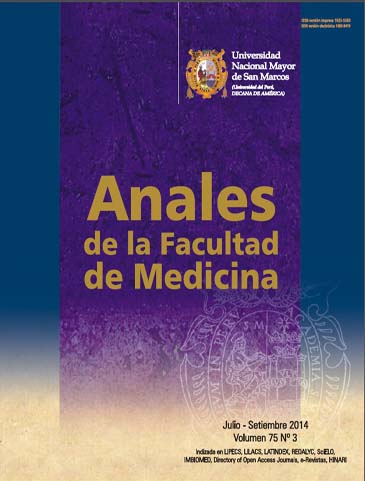External user’s complaints in a national reference pediatric center
DOI:
https://doi.org/10.15381/anales.v75i3.9779Keywords:
Complaints, quality of health care, user´s satisfaction, hospitals, specialized hospitals, child, Lima, Peru.Abstract
Objective: To identify complaints characteristics of external users in a national pediatric reference center. Design: Descriptive, retrospective study. Setting: Instituto Nacional de Salud del Niño (INSN), Lima, Peru. Material: Book of Complaints. Methods: A database was elaborated from the INSN Book of Complaints for the period July 2011 to September 2012. The patient could have had more than one complaint reason. Main outcome measures: Demographic data, frequency, motives, time of resolution, alluded personnel, and solution of complaints. Results: Two hundred and eighty-three formats were collected containing 358 complaints. Most frequent complaint reasons were: inappropriate attitude 32.1%, long waiting time 18.4%, deficient information 14.5%, deficient access to services 9.5%, loss of documentation (laboratory results or x-rays, formats, clinical records, among others) 7.8%, problems in communication 7.5%, privileged access to attention 5.9%, objective aspects (facilities, appearance, cleaning, equipment) 4.2%. The areas that received more complaints were: outpatient attention by physicians 41.7% (rate of 0.5 per thousand patients), security 9.2%, private hospital service 9.2%, and cashiers 6.0%. Sixty per cent of claims were solved, and of these 84.2% were solved before 4 weeks since the complaint. Occupational groups generating complaints were: physician (26,4%), nurse technician (13,9%), administrative personnel (12,2 %), security personnel (12,2%), archive personnel (9,7 %), nurse (9,0 %), cashier (5,9 %), admission (2,1%). Conclusions: Complaints’ characteristics suggest the need to take appropriate corrective and educational measures, so as to avoid or decrease them. Routine periodic evaluation of complaints is necessary to increase user’s satisfaction.Downloads
Published
2014-09-15
Issue
Section
Trabajos originales
License
Copyright (c) 2014 Roberto Shimabuku, Danitza Fernández, Gladys Carlos, Katia Granados, Ruth Maldonado, Graciela Nakachi

This work is licensed under a Creative Commons Attribution-NonCommercial-ShareAlike 4.0 International License.
Those authors who have publications with this magazine accept the following terms:
- Authors will retain their copyrights and guarantee the journal the right of first publication of their work, which will be simultaneously subject to Creative Commons Attribution License that allows third parties to share the work as long as its author and its first publication this magazine are indicated.
- Authors may adopt other non-exclusive licensing agreements for the distribution of the version of the published work (eg, deposit it in an institutional electronic file or publish it in a monographic volume) provided that the initial publication in this magazine is indicated.
- Authors are allowed and recommended to disseminate their work over the Internet (eg: in institutional telematic archives or on their website) before and during the submission process, which It can produce interesting exchanges and increase quotes from the published work. (See El efecto del acceso abierto ).
How to Cite
1.
Shimabuku R, Fernández D, Carlos G, Granados K, Maldonado R, Nakachi G. External user’s complaints in a national reference pediatric center. An Fac med [Internet]. 2014 Sep. 15 [cited 2025 Jun. 8];75(3):245-50. Available from: https://revistasinvestigacion.unmsm.edu.pe/index.php/anales/article/view/9779



